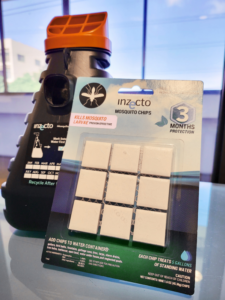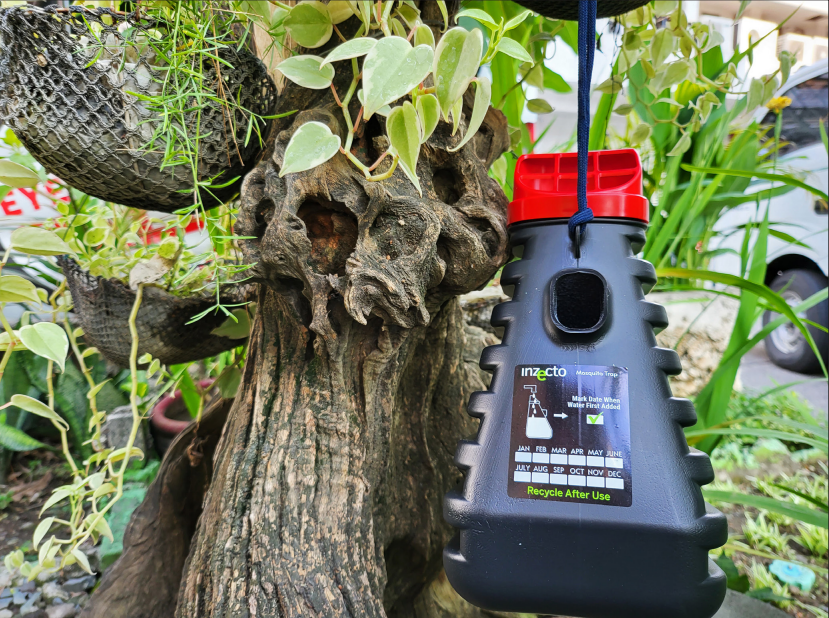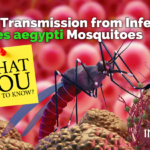Ovitraps for Mosquito Control
Ovitraps for Mosquito Control
An ideal technology for modifying the breeding sites in public and private spaces Partho Dhang
The current pace of urbanization has significantly contributed to creating innumerable mosquito habitats.
Human behaviour of carelessness towards water management and sanitation has been an added factor to this burden. But the last and the newest contributor to the overall mosquito menace is Climate Change. Mosquito populations are on the increase and now moving towards previously cooler territories where temperatures are climbing due to Global Warming. This includes temperate regions of the world as mosquitoes spread towards the poles. Mosquitoes are also being recorded at higher altitudes where they were previously not recorded, exposing new communities to mosquito-borne disease where they previously did not exist. Put together, the burden from mosquito borne diseases in on an increase.
Mosquito control has largely been dependent on insecticides, but in the last few years several innovative technologies have been developed based on genetic, physical, and behavioural principles. These include Sterile Insect Technique (SIT), Release of Insects Carrying a Dominant Lethal (RIDL) gene, creating transgenics with abnormal and lethal genes, and reducing the vectorial capacity or fecundity through the injection of Wolbachia into the mosquito. These technologies have shown promise but unlike insecticides their wider implementation is logistically challenging and extremely expensive.
Urban Challenges with Mosquito Control
Cities and towns face a unique situation where large parts are privately owned such as homes, office complexes, schools, hotels, resorts, and golf courses. These properties continuously seek mosquito free environment and providing a working solution is often challenging. The challenges come from the fact that often mosquitoes breeding in another territory invade these private locations for feeding. The other issue is that the conventional treatment of spaces by insecticides often face objections, as drift from the treatment invariably reach neighbouring properties. Such settings have however created opportunity for manufacturers and pest control practitioners to fill into and provide this essential public service. Consequently, mosquito control in urban areas is often dependent on private enterprises, particularly inside private properties, and compounds. It has turned to be a commodity well traded between consumers and pest control practitioners, thus providing incentives for innovative technologies.
In the last decade many such technologies have been developed, tested, and registered for use in urban environments. From the client point of view these technologies have generated interest as these are specific, address both adult and larvae, do not use pesticide or if they use any pesticide, the quantity is negligible. They also do not interfere and do not contaminate non target areas such as water bodies, and more importantly, they are adaptable to situations.
Lethal Ovitraps
In the last decade a small number of technologies have emerged with strong prospects of widespread adoption in the urban environment. One such technology with a good potential are lethal ovitraps. These traps have found a particular favour with an increased interest in the management of Aedes container breeding mosquitoes, notably Aedes aegypti and Aedes albopictus. These species have gained the reputation of being a major public enemy across the world for their propensity for aggressive biting and being able to transmit pathogens that cause diseases such as dengue, zika, and Chinkungunya. Both Aedes are urban mosquitoes with a propensity for human blood, and with a preference for living and breeding around humans and in human made objects. These species occur in close proximity to humans; they rest amongst household objects both indoor and outdoor, and utilize all available sources of freshwater held in natural and artificial objects for breeding.
Lethal ovitraps exploit the container breeding Aedes mosquitoes’ need to lay eggs in waterholding containers in and around the vicinities of humans. As Santos de Abreu (2015) summed up, the preferred containers for the deposition of eggs are preferably of large volume, dark coloured, contain stagnant water with a low concentration of decomposing organic matter, and sites that reduce exposure to parasites, predators, and competition, as well as having an increased access to food.
Ovitraps provide a suitable water holding area for the mosquitoes to lay eggs, in addition to having features that make them attractive. Invariably the water in these traps is laced with an insecticide, generally an insect growth regulator, which prevents larval development thus reducing the mosquito population. Some ovitraps also contain a second insecticide, which could be an entomopathogenic bacteria or a fungus to help the process of autodissemination. The autodissemination process helps the ‘skip-ovipositing’ females to spread the potent larvicide to other oviposition sites in the environment.
Some advanced lethal ovitraps have exploited the characteristic skip-oviposition behaviour demonstrated by female Aedes container breeding mosquitoes to become more effective. ‘Skip oviposition’ means that the female mosquito lay eggs in batches, in several different water containers during a single gonotrophic cycle, which happens in a relatively short space of time (note that some mosquitoes like Tripteroides and Toxorhynchites flick their abdomen when laying eggs, such that the eggs skip across the water surface; this is a completely different behaviour to that of the Aedes mosquitoes being discussed). Studies have shown both Aedes aegypti and Aedes albopictus follow this behaviour. Both species distribute their eggs more evenly under nutritionally enriched oviposition media conditions. Under nutritionally unenriched (tap water) oviposition media, both Aedes aegypti and Aedes albopictus increased egg spreading behaviour (Reinbold-Wasson and Reiskind, 2021). In one study, it was found that the number of breeding sites that were used was proportional to the number available. Females used 4-6 breeding sites on average, with a maximum of 11 out of 16 provided. A favoured site received as many as 40% of the eggs laid (Santos de Abreu,2015).
INZECTO Ovitrap
‘Skip oviposition’ behaviour observed in Aedes container breeding species means that using ‘source reduction’ as a control method, in which water-holding containers are diligently removed or emptied, is less likely to be effective. In such situations, the ovipositing mosquito will scout for other available water bodies including unconventional ones, as well as travel far looking for a new source. Ecologically this can mean the potential dispersal of diseases, a good ground for ovitraps to exploit.
INZECTO is a new ovitrap on the market. The trap design and the technology evolved from detailed research undertaken by Parker and colleagues (2017).
The trap is a durable, dual action ovitrap with several innovative features. The black and red coloring of the trap is proven to significantly attract more female mosquitoes. Researchers have found that the color red at the entrance had a higher positive response than any other factor when testing traps for Aedes mosquitoes. The sides of the trap have a ribbed structure to reduce airflow, as mosquitoes prefer windprotected areas (Figure 1). The trap also includes a leaf-infusion mixture as a food source for the larvae and the female mosquito finds it an attractive environment to lay her eggs. This is evident from the average number of eggs laid in traps with leaf infusion that were significantly higher than the average number of eggs laid in a control trap with just water (Parker et al., 2017).
The trap design also has an overflow spout to ensure the trap cannot overfill with water, allowing mosquitoes continuous access to the water surface. The trap uses two forms of insecticide, namely a larvicide (pyriproxyfen) to prevent the emergence of adults from the larvae, and an adulticide (permethrin) to kill female mosquitoes as they land to lay eggs. These insecticides are embedded in the inner surface of the trap within a polymer formulation that protects the chemicals from degradation and allows their slow release over time. The larvicide is activated by contact with water. This design neatly overcomes some of the problems of other water-based control methods, as the insecticide remains present in the trap even if the water dries up.
The proof of the trap’s efficacy can be obtained from several studies. In one test, the INZECTO mosquito trap was shown to be the preferred location for mosquitoes to lay their eggs. Aedes mosquitoes prefer to lay their eggs in several containers to avoid laying all their eggs in one location, as noted above. However, in a University of Florida study, the INZECTO trap reduced the number of eggs laid in other containers by 94%. In that experiment, 20 blood-fed mosquitoes were released into a cage that had an oviposition cup lined with paper for egg laying. Without an INZECTO trap, there were 842 eggs laid in the cup. When an INZECTO trap was placed in the cage, there were only 53 eggs laid in the cup. Another 375 eggs were laid in the INZECTO trap and were prevented by pyriproxyfen from developing into biting adults. The total number of eggs laid in the treated cage was also reduced because of adults contacting permethrin and dying (Koehler and Pereira, 2023).
Conclusion
The INZECTO ovitrap is simple and quick to set up, as users need only to add water. The trap remains lethal for three months. The life of the trap can be further increased by another three months by addition of a mosquito chip that tops up the insecticide (Figure on the right). The trap is undoubtably an effective tool for control of Aedes as the trap displayed a competitive advantage compared with other small, common oviposition sites in the environment. In the laboratory studies, the trap resulted in 95–100% mortality of ovipositing females in addition to preventing all eggs from developing into biting adult mosquitoes. The traps effectively prevented adult mosquito emergence and caused at least 50% mortality in adult mosquitoes for up to six months.
No single technology provides a magic bullet for mosquito control. The selection of mosquito management technologies should depend on the species concerned, the local circumstances, and involve a combination of approaches to be effective and sustainable. This includes integration with other environmental management, urban services, and health programs.
COI Statement: Dr Patho Dhang has no commercial links to Inzecto and is not a paid consultant by the company. There are other ovitraps on the market and the Inzecto has yet to be directly compared with these in independent studies.
References
Koehler P. and Pereira R. (2023). Mosquito control, the INZECTO solution. https://researchoutreach.org/articles/mosquito-control-inzecto-solution/
Parker C.N., Pereira R.M., Baldwin R.W., Chaskopoulou A. and Koehler P.G. (2017). Laboratory evaluation of a novel lethal ovitrap for control of Aedes aegypti. Journal of Medical Entomology, 54: 1666-1673. https://doi.org/10.1093/jme/tjx161
Reinbold-Wasson D.D. and Reiskind M.H. (2021). Comparative skip-oviposition behavior among container breeding Aedes spp. mosquitoes (Diptera: Culicidae). Journal of Medical Entomology, 58: 2091-2100. https://doi.org/10.1093/jme/tjab084
Santos de Abreu F.V., Morais M.M., Ribeiro S.P. and Eiras A.E. (2015). Influence of breeding site availability on the oviposition behaviour of Aedes aegypti. Memórias do Instituto Oswaldo Cruz, 110: 669-676. https://doi.org/10.1590/0074-02760140490
Dr Partho Dhangis an Independent Consultant, Manila, Philippines.




